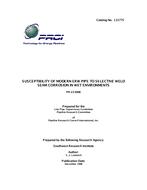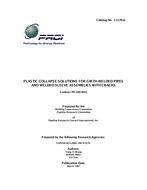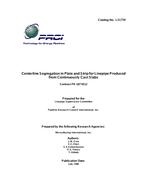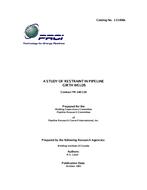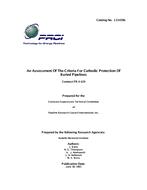Provide PDF Format
PRCI PR-15-9306
- Susceptibility of Modern ERW Pipe to Selective Weld Seam Corrosion in Wet Environments
- Report / Survey by Pipeline Research Council International, 02/01/1998
- Publisher: PRCI
$48.00$95.00
L51775e
Southwest Research Institute
Need: Grooving corrosion is a phenomenon by which the weld seam of electric resistance welded (ERW) pipe is preferentially attacked in wet natural gas environments containing CO,. The attack initiates as an aligned string of pits which grow and intersect, forming a round-bottomed groove of damage centered on the weld seam. The susceptibility of ERW pipe to this damage mechanism is known to be related to the chemical composition (particularly the sulfur content) of the pipe, the welding process employed, and the use of a post weld heat treatment. Of particular concern to the natural gas pipeline industry is the fact that at the resent time there are no effective means for predicting the susceptibility of a specific lot of ERW pipe to grooving corrosion, prior to placing the pipeline in service.
Benefit: The objective of this program, therefore, is to begin the development of an accelerated laboratory test technique which may be useful as a screening test to establish the susceptibility of an ERW weld to grooving corrosion. A stepped potential, potentiostatic electrochemical test method was used to evaluate the susceptibility of ERW welds from five different pipe samples to grooving corrosion in environments representative of natural gas production. Three of the welds were believed to be susceptible to grooving corrosion and the remaining two were believed to be non-susceptible. Testing was performed under a variety of conditions (environment chemistry, temperature, and levels of polarization) in an attempt to identify conditions which enabled the correct differentiation between the susceptible and non-susceptible specimens.
Result: Of the six environment/temperature combinations tested, the CO2 + O2 /RT condition produced the best differentiation. Four of the five welds were clearly and correctly categorized. However, one weld believed to be non-susceptible developed a shallow groove during the test. This result would be a false positive, but conservative assessment. Based on these results, it can be concluded that electrochemical test methods are a promising technique for accelerated screening of ERW weld seam susceptibility to grooving corrosion. Future work in this area should focus on refining the test conditions which provide the most accurate differentiation, and then transition to a testing system which can be conducted at ambient pressures, and preferably without the need for an electronic potentiostat.
Southwest Research Institute
Need: Grooving corrosion is a phenomenon by which the weld seam of electric resistance welded (ERW) pipe is preferentially attacked in wet natural gas environments containing CO,. The attack initiates as an aligned string of pits which grow and intersect, forming a round-bottomed groove of damage centered on the weld seam. The susceptibility of ERW pipe to this damage mechanism is known to be related to the chemical composition (particularly the sulfur content) of the pipe, the welding process employed, and the use of a post weld heat treatment. Of particular concern to the natural gas pipeline industry is the fact that at the resent time there are no effective means for predicting the susceptibility of a specific lot of ERW pipe to grooving corrosion, prior to placing the pipeline in service.
Benefit: The objective of this program, therefore, is to begin the development of an accelerated laboratory test technique which may be useful as a screening test to establish the susceptibility of an ERW weld to grooving corrosion. A stepped potential, potentiostatic electrochemical test method was used to evaluate the susceptibility of ERW welds from five different pipe samples to grooving corrosion in environments representative of natural gas production. Three of the welds were believed to be susceptible to grooving corrosion and the remaining two were believed to be non-susceptible. Testing was performed under a variety of conditions (environment chemistry, temperature, and levels of polarization) in an attempt to identify conditions which enabled the correct differentiation between the susceptible and non-susceptible specimens.
Result: Of the six environment/temperature combinations tested, the CO2 + O2 /RT condition produced the best differentiation. Four of the five welds were clearly and correctly categorized. However, one weld believed to be non-susceptible developed a shallow groove during the test. This result would be a false positive, but conservative assessment. Based on these results, it can be concluded that electrochemical test methods are a promising technique for accelerated screening of ERW weld seam susceptibility to grooving corrosion. Future work in this area should focus on refining the test conditions which provide the most accurate differentiation, and then transition to a testing system which can be conducted at ambient pressures, and preferably without the need for an electronic potentiostat.
Related Products
PRCI PR-187-9212
Centerline Segregation in Plate and Strip for Linepipe Produced from Continuously Cast Slabs..
$198.00 $395.00
PRCI PR-3-129
An Assessment of the Criteria for Cathodic Protection of Buried Pipelines..
$98.00 $195.00

